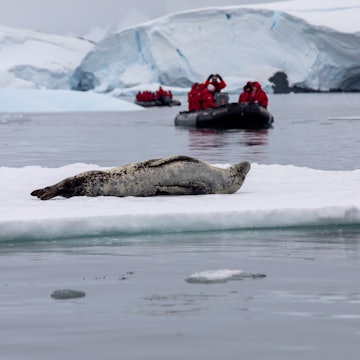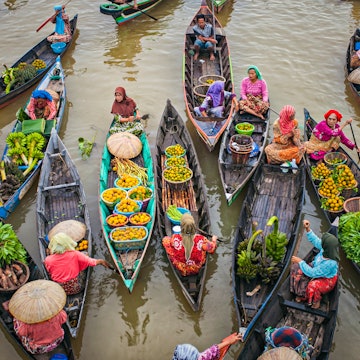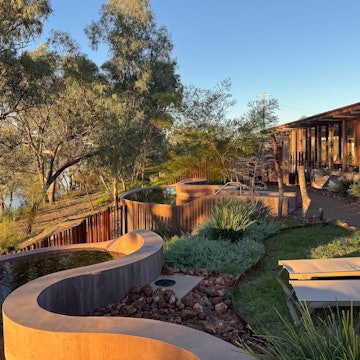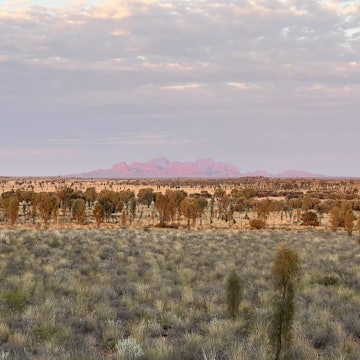
Queensland by Sea: Vivid experiences on and under the water
Sponsored by

Mar 31, 2021 • 5 min read

Whether on or under the waves, it can be hard to know where to start your Great Barrier Reef adventure © Courtesy of Tourism & Events Queensland
Australia’s Great Barrier Reef is without a doubt one of the most important and bio-diverse wonders on the planet.
Spanning more than 1,400 miles in length from Bundaberg in southern Queensland to Cape York at the northernmost tip of Australia, and covering an area the equivalent of 70 million football fields, it’s the largest natural feature on earth.
The Great Barrier Reef supports an impressive array of sea life, including ‘The Great Eight’ – clownfish, giant clams, manta rays, Maori wrasse, potato cod, docile reef sharks, turtles and whales, who all call the reef home. Attempting to find them all on a snorkel safari is more than a check-box activity, but each one a deeply profound encounter that stays with you.
Whether diving or snorkeling, immersing yourself in jaw-dropping ‘bommie,’ – underwater mega-cities of colorful coral and schools of flitting fish – is a memorable way to get close to it all. Coming from the Indigenous word ‘bombora,’ meaning ‘mountain of reef,’ this local slang is just one of the terms that will quickly make its way into your vocabulary.
Comprising 2,900 coral reefs, 600 continental islands and 300 coral cays, it can be hard to know where to start your Great Barrier Reef adventure. Here are just some of the ways to explore via popular gateways off the Queensland coast.

Port Douglas
About an hour’s drive north of Cairns, Port Douglas is the northernmost main access point to the Great Barrier Reef.
The Ribbon Reefs north of Port Douglas are arguably the best stretch of ocean in the world. Accessible by catamaran in 90 minutes, Agincourt Reef and its no less than 16 dive sites, is particularly renowned. Here you are truly on the outer reef, sitting on the edge of the Continental Shelf, which just 1.2 miles further sees the ocean floor drop to depths of 1600-plus feet.
The clean, clear water of the deep ocean constantly washing over this natural divide is said to be the reason for Agincourt Reef’s incredible visibility, prolific coral growth and spectacular marine life. Agincourt can be enjoyed both in and out of the water with dives and snorkeling for all levels, glass-bottom boats and underwater observatories.

Cairns
If you’re curious about what lies north of Agincourt Reef, expeditions from Cairns can take you there. This wild and virtually untouched area of the Marine Park takes some time to get out to, making it an ideal location to do a multi-day liveaboard experience.
South of Lizard Island, be sure to visit Cod Hole, where divers can get face-to-face with friendly two-meter-long potato cod, and around June and July, divers and snorkelers alike have the chance to swim with dwarf minke whales who come to the area on their annual migration, the only place in the world you can do so.
For an idyllic island getaway closer to the mainland, it’s hard to look past Fitzroy Island, just 45 minutes by boat from Cairns. This reef-meets-rainforest island paradise is everything you’d expect a picture-perfect Queensland vacation to be, with enviable beaches, incredible views, and reef snorkeling and kayaking accessible right from the shoreline. While you’re there, see first-hand how injured turtles are cared for at the on-site turtle rehabilitation center.

Townsville
An ideal place to start your sea exploration in Townsville is at Reef HQ, the world's largest living coral reef aquarium and the official national education center for the Great Barrier Reef. A visit will make your reef adventure even more memorable by giving amazing insight into what you will see out there.
Once you’re ready to head onto the water, there’s nowhere more convenient than Magnetic Island, just five miles offshore and a 20-minute ferry ride away. A fun way to explore is by renting an open-air ‘Barbie’ car and zipping around to the island’s 23 beaches.
Wildlife enthusiasts will appreciate that Magnetic Island is home to the largest population of wild koalas in Australia. Spot them on the 2.5-mile round-trip Forts Walk hike, which also takes you to a lookout over the entire island, and then end the day at Horseshoe Bay for a magnificent sunset.
Some 40 miles south and three hours by fast boat from Townsville is the wreckage of the 4100-ton, 360-foot-long S.S. Yongala, Australia’s largest and most intact historic shipwreck. Now teeming with sea life, it’s one of the ‘Top 10’ best dive sites in the world and absolutely not-to-be-missed by experienced divers able to fulfill the PADI and logged dive requirements.

The Whitsundays
If you were to conjure up an image of paradise, it would probably look exactly like the Whitsundays. An archipelago of 74 tropical islands, it’s the kind of holiday destination dreams are made of.
Right in the heart of the Great Barrier Reef surrounded by turquoise-hued waters, just about any water activity beckons, but you'd be hard pressed to find a place where a yacht doesn’t look more at home.
Hamilton Island, Daydream Island, Hayman Island and Long Island all feature resort accommodation, but no trip to the Whitsundays is complete without a visit to Whitehaven Beach. Located on Whitsunday Island, Whitehaven Beach is a jaw-dropping 4.3-mile stretch of the finest white silica sand. Venture to its most-photographed point at Hill Inlet, where the sand and sea meet to create gorgeous swirls in the changing tides.

Southern Reef Islands
When Sir David Attenborough was asked where he would like to film his last on-location documentary, he answered without hesitation: “The Great Barrier Reef.” Visitors can follow in the famed naturalist’s footsteps by exploring some of his favorite locations in the Southern Reef Islands.
Lady Elliot Island and Heron Island are both excellent examples of eco-tourism activities, where reef science meets sustainable luxury. Heron Island boasts the largest island-based research station in the southern hemisphere and at Lady Elliot, visitors can put their snorkeling time to good use by helping to document the surrounding reefs via citizen science projects.
Along with Heron, the camping-only Lady Musgrave Island is an important nesting ground for green and loggerhead turtles. All three islands feature world-class diving and snorkeling, with Lady Elliot being one of the top five places on the planet to dive with manta rays.
You might also like
Queensland by Air: Get a bird’s eye view of the riches below
Queensland by Land: Lush forests, open beaches and fascinating culture
Sponsored by Queensland
As a travel entertainment and inspirational media outlet, we sometimes incorporate brand sponsors into our efforts. This activity is clearly labeled across our platforms.
This story was crafted collaboratively between Queensland and Lonely Planet. Both parties provided research and curated content to produce this story. We disclose when information isn’t ours.
With sponsored content, both Lonely Planet and our brand partners have specific responsibilities:
-
Brand partner
Determines the concept, provides briefing, research material, and may provide feedback.
-
Lonely Planet
We provide expertise, firsthand insights, and verify with third-party sources when needed.













